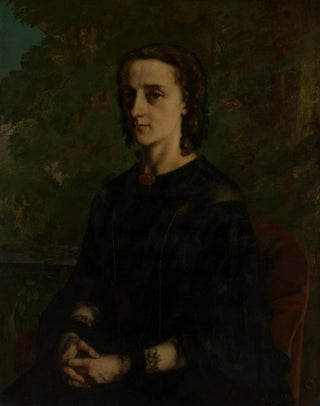Art print | Madame Frédéric Breyer Fanny Hélène Van Bruyssel 1830-1894 - Gustave Courbet


View from behind

Frame (optional)
Gustave Courbet's artwork, "Madame Frédéric Breyer Fanny Hélène Van Bruyssel 1830-1894," stands as a true testament to the artistic sensitivity of the 19th century. Through this portrait, Courbet does not merely capture the physical appearance of his model but manages to seize the very essence of her personality. The canvas, evoking intimacy and the depth of human relationships, invites viewers to reflect on the gaze and thoughts of the depicted woman. This painting, imbued with a gentle yet intense atmosphere, transports us to a universe where art becomes a means of expressing emotions and feelings.
Style and uniqueness of the art print
Courbet's style is distinguished by its bold realism, aiming to represent reality without embellishment. In this art print, the features of Fanny Hélène Van Bruyssel are rendered with remarkable precision, each detail carefully crafted to convey the liveliness of her gaze and the delicacy of her expression. The color palette used by the artist, oscillating between warm tones and darker shades, helps create an intimate and warm atmosphere. The composition, focused on the face and bust of the model, immediately draws attention and fosters an emotional connection with the viewer. Courbet, employing techniques of light and shadow, manages to bring his subject to life, making this art print not only a simple reflection of beauty but also a profound exploration of the human psyche.
The artist and his influence
Gustave Courbet, an emblematic figure of the realist movement, left a significant mark on art history through his innovative approach. Born in 1819, he distinguished himself by rejecting the academic conventions of his time, preferring to depict life as it is, with its joys and sorrows. His influence was decisive for many artists who followed, notably the Impressionists, who also sought to capture light and the present moment. Courbet was able to inject a new dynamic into the painting of his era, in

Matte finish

View from behind

Frame (optional)
Gustave Courbet's artwork, "Madame Frédéric Breyer Fanny Hélène Van Bruyssel 1830-1894," stands as a true testament to the artistic sensitivity of the 19th century. Through this portrait, Courbet does not merely capture the physical appearance of his model but manages to seize the very essence of her personality. The canvas, evoking intimacy and the depth of human relationships, invites viewers to reflect on the gaze and thoughts of the depicted woman. This painting, imbued with a gentle yet intense atmosphere, transports us to a universe where art becomes a means of expressing emotions and feelings.
Style and uniqueness of the art print
Courbet's style is distinguished by its bold realism, aiming to represent reality without embellishment. In this art print, the features of Fanny Hélène Van Bruyssel are rendered with remarkable precision, each detail carefully crafted to convey the liveliness of her gaze and the delicacy of her expression. The color palette used by the artist, oscillating between warm tones and darker shades, helps create an intimate and warm atmosphere. The composition, focused on the face and bust of the model, immediately draws attention and fosters an emotional connection with the viewer. Courbet, employing techniques of light and shadow, manages to bring his subject to life, making this art print not only a simple reflection of beauty but also a profound exploration of the human psyche.
The artist and his influence
Gustave Courbet, an emblematic figure of the realist movement, left a significant mark on art history through his innovative approach. Born in 1819, he distinguished himself by rejecting the academic conventions of his time, preferring to depict life as it is, with its joys and sorrows. His influence was decisive for many artists who followed, notably the Impressionists, who also sought to capture light and the present moment. Courbet was able to inject a new dynamic into the painting of his era, in






